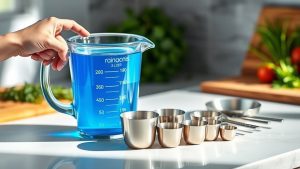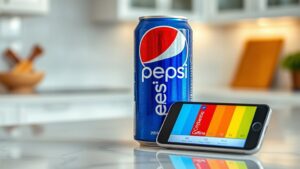How to Convert 3 Liters to Ounces Easily
Knowing how to convert 3 liters to ounces easily can enhance your cooking skills; discover the simple formula that makes it effortless!

To convert 3 liters to ounces easily, just multiply by 33.814. So, 3 liters times 33.814 equals approximately 101.442 ounces. This simple formula can help you quickly switch between metric and imperial measurements, whether you're tracking hydration or following a recipe. Accurate conversions are essential in cooking and science, so knowing this method is highly beneficial. Keep going, and you'll uncover more handy tips for mastering measurement conversions.
When you need to convert liters to ounces, understanding the difference between these two units is fundamental. Liters measure volume, while ounces can refer to either weight or fluid volume, depending on the context. This distinction is especially significant when dealing with cooking, hydration tracking, or following precise recipes. Since liters are part of the metric system and ounces belong to the imperial system, knowing how to convert between these two is essential for accurate measurements.
To convert liters to ounces, you can use a straightforward formula: Ounces = Liters × 33.814. This formula tells you that one liter is approximately equal to 33.814 US fluid ounces. For example, if you want to convert 3 liters to ounces, you simply multiply 3 by 33.814. This calculation results in approximately 101.442 ounces. This level of precision is critical, especially in cooking, where accurate measurements can make or break a recipe.
To convert liters to ounces, multiply the liters by 33.814 for precise measurements in cooking and recipes.
In practical applications, converting liters to ounces can help you monitor your water intake throughout the day. If you aim to drink a specific amount of water, knowing how many ounces are in the liters you plan to consume can aid in tracking your hydration goals. Similarly, when cooking or baking, many recipes require specific measurements, and understanding how to convert between these units guarantees that you use the right amount of ingredients. Conversion calculators can assist in achieving precise measurements.
Moreover, if you're purchasing beverages, a good grasp of these conversions can help you compare quantities more effectively. For instance, if a drink is sold in liters and you're used to measuring in ounces, being able to convert helps you understand exactly how much you're getting. This skill can also be beneficial in scientific or medical contexts, where accurate conversions guarantee the precision of studies and dosages.
While the basic conversion formula is effective, remember that density plays a role if you're converting between volume and weight. If you're working with a substance where you need to know its density, such as in recipes or scientific measurements, you'll need to factor that in. For example, if you have an ingredient with a density of 0.7 g/mL, and you want to convert 5 liters to ounces, you'd use the formula: Ounces = 5 × 35.274 × 0.7. This approach provides a more accurate weight measurement.
For quick reference, you can find conversion tables that list common conversions like 1 liter to 33.814 ounces or online calculators that make these conversions even easier. Manual calculations can be reliable for simple conversions, making sure you maintain accuracy in your measurements.
Conclusion
Converting liters to ounces is a simple process that can come in handy in various situations. For instance, 3 liters is equivalent to about 101.44 ounces, which means you're looking at over 12 standard cups of liquid! This visual helps you grasp just how much volume that really is. Whether you're measuring ingredients for a recipe or tracking your water intake, knowing how to make this conversion easily will definitely simplify your life.








